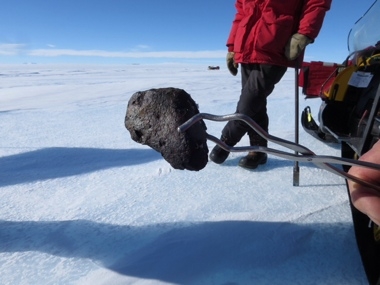 When we look at the sky during the night, we sometime see a star falling and making a streak of light in the atmosphere as it falls. Ultimately, it disappears. It, in fact, disintegrates. Such heavenly bodies falling after disintegration are not stars – they are meteorites. They are of varying sizes.
When we look at the sky during the night, we sometime see a star falling and making a streak of light in the atmosphere as it falls. Ultimately, it disappears. It, in fact, disintegrates. Such heavenly bodies falling after disintegration are not stars – they are meteorites. They are of varying sizes.
Whenever any one of the celestial bodies, while making revolutions, comes nearer to the earth, it is attracted towards the earth due to its force of gravitation. Attraction of the earth increases the velocity of the body and this, in turn, increases friction with the atmospheric air. Consequently, it becomes very hot. As a result of this, hot gases start coming out of it. These gases start burning and the atmosphere is lighted. The sound of friction in the air is heard over long distance. Because of heat and friction, the body disintegrates into small pieces which are scattered in the atmosphere. But some of these meteorites are so big that they are not completely destroyed in the atmosphere and some of their parts fall on the earth.
Meteorites become visible to us only when they are in the atmosphere, at a height of 112 km from the earth. Majority of them are destroyed in the atmosphere by the time they come down to a height of 80 km. Their downward velocity ranges from 160 km to 200 km per sec. They fall down both during the day and the night, but they are not visible during the day because of the bright sunlight.
Meteorites are, in fact, pieces of comets. Whenever the earth approaches the orbit of some comet, some pieces of it are attracted towards the earth. These pieces may be either big or small. The biggest meteorite reaching the earth weighed 37 tons.


 All bodies of the universe attract each other. This force of attraction is called the force of gravitation. It was Newton who propounded the law of gravitation. The force of gravitation between two bodies depends upon two things – their masses and the distance between them. The greater the masses of the bodies, the greater will be the force of attraction. But, with the increase distance between them, the force as a consequence decreases. As a matter of fact, if the distance between two bodies is doubled, the force of attraction will be reduced to one-fourth.
All bodies of the universe attract each other. This force of attraction is called the force of gravitation. It was Newton who propounded the law of gravitation. The force of gravitation between two bodies depends upon two things – their masses and the distance between them. The greater the masses of the bodies, the greater will be the force of attraction. But, with the increase distance between them, the force as a consequence decreases. As a matter of fact, if the distance between two bodies is doubled, the force of attraction will be reduced to one-fourth.

 Saturn is the second largest planet of the Solar System. On the basis of the distance from the Sun, this is the sixth planet. Its distance from the Sun is 1,427 million km. Its intense brightness is due to its bigger size. It keeps on revolving round the Sun and takes about 291 years to complete one revolution. It has seventeen moons revolving round it. It appears yellow in colour. It is 96 times heavier than the Earth, while its volume is 743.7 times more than that of the Earth.
Saturn is the second largest planet of the Solar System. On the basis of the distance from the Sun, this is the sixth planet. Its distance from the Sun is 1,427 million km. Its intense brightness is due to its bigger size. It keeps on revolving round the Sun and takes about 291 years to complete one revolution. It has seventeen moons revolving round it. It appears yellow in colour. It is 96 times heavier than the Earth, while its volume is 743.7 times more than that of the Earth.

 Billions of stars which we see in the sky every night are made up of hot gases. Even the Sun is a star. However, there are stars which are million times more shining than the Sun, but they don’t appear so because of their greater distances from the earth. The stars are of varying sizes.
Billions of stars which we see in the sky every night are made up of hot gases. Even the Sun is a star. However, there are stars which are million times more shining than the Sun, but they don’t appear so because of their greater distances from the earth. The stars are of varying sizes.